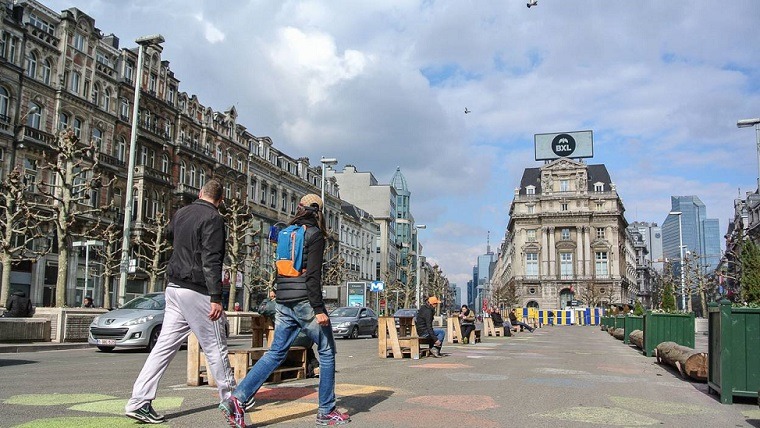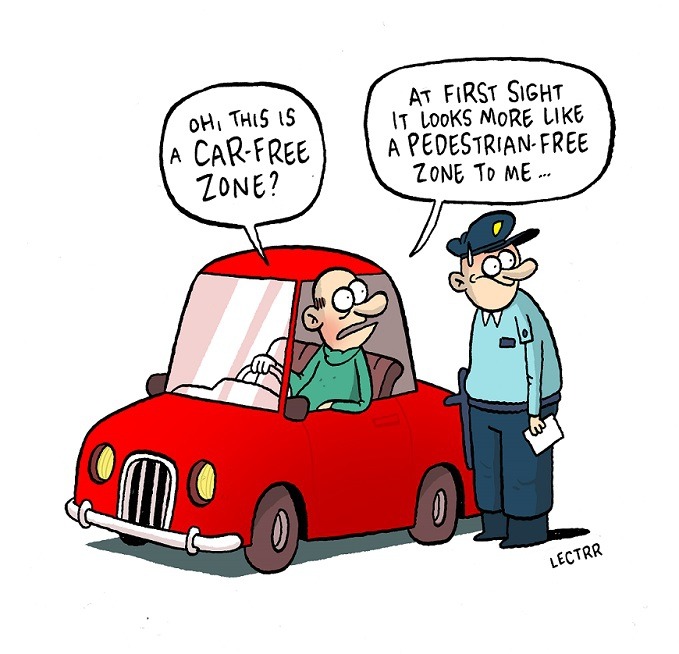Better than Barcelona. That was how Brussels’ pedestrian scheme was billed when the idea was first mooted in 2014. The ambitious project to turn part of the centre of the city into a car-free zone was, according to a spokesman for Alderwoman Else Ampe, to make it comparable to Las Ramblas, the famous shopping thoroughfare in the Catalan capital.
But, over two years since the central avenues in Brussels were closed to traffic, retailers are still complaining about a loss of trade. Worse still, maybe, many are still asking: “So, what exactly will the pedestrian centre look like?” The reason people are still asking that question is that a series of legal challenges have very much slowed progress on the scheme. The exact timing to the start of the project in earnest hinges largely on whether there are any more legal obstacles from retailers or anyone else who opposes the plans.
The long-running saga dates back to November 2014 when the city authorities formally launched the car-free street plan. Taking their cue from other Belgian cities, like Leuven, Ghent and Bruges, which had successfully introduced such schemes, the idea was to do to the same in the capital, creating what was billed as the largest car-free zone in Europe after Venice.
The goal was to stop traffic in the city centre while allowing it to remain accessible to residents and tourists.

Original concept image of the future De Brouckère square during the early stages of the project. Three years on, the city is still far away from the original vision. When the pedestrian zone came into force in summer 2015, there was a sense of excitement and change in the city. However, as the works kept dragging out, many locals expressed frustration and shops and restaurant complained of loss of income. Although a recent survey amongst shop owners in the city centre still show overwhelming support with some 85% in favour of the car-free zone in the central boulevards, a whopping 92% believe it was badly implemented. © Brussels City
Critics soon argued that it would merely shift traffic flows to other areas and retailers in the affected area were quick to point to a likely loss of income. Notwithstanding such fears, the pedestrian zone came in to force in the summer of 2015 when central avenues from Place Fontainas to De Brouckere were closed.
However, it wasn’t long before things started to go bumpy with two associations representing businesses in the zone making a complaint to the Council of State on the grounds that no impact assessment was ever done and a lack of consultation. Even the scheme’s proponents conceded that, in the first year of its existence, the local economy took a hit with sales down by as much as 20 per cent.
Despite concerted attempts to get the pedestrian plans overturned, in July 2015 three squares including the Bourse, plus the section of Boulevard Anspach that connects them, were pedestrianised. Today, the same area remains car free and there are renewed hopes that the long-awaited improvements to its infrastructure will now finally get underway. Despite placing barriers to stop traffic and some street furniture (not to mention, an extra 3,000 metres of cycle lanes) the area is still a far cry from Barcelona’s wonderful Ramblas.
So, falling shop sales, court action aside, what exactly can the good folk of Brussels look forward to with this much-mooted pedestrian scheme? Well, works are due to commence in the coming months with the installation of new green spaces, fountains, including a new water feature in front of the Marriott Hotel, “smart” rubbish bins, art work, plenty of new trees and street furniture, bike parking facilities and yet more cycle lanes (though not necessarily directly in the pedestrian zone itself).
Plans have also been mooted for what is called a “unified ground surface” in blue stone. There will also be more improvement work on the Bourse and De Brouckere metro stations. A free electric train for pedestrians and tourists and five new underground car parks to hold 1,600 cars may also be built. All this excludes Place de la Bourse, which, as part of the listed zone for the historic city centre, is subject to another procedure. The improvements will be done in phases and, overall, the total project has an estimated cost of some €33 million to be financed by the federal government. It is expected that everything will be completed by the end of next year.
Pedestrianisation has not pleased everyone - shop owner Alain Berlinblau mounted a legal challenge, appealing against the city government's urban development permit. He claims it has deterred potential customers, preventing them from accessing car parks. You would have thought Jerome Vandermuelen, founder of Manhattn’s restaurant, would also be another critic. He chose to locate a second burger restaurant in the middle of the car-free zone and, like many other city centre businesses, took a real hit after the March 2016 terrorist atrocity, which saw much of the city under lockdown for weeks. Despite the many problems the scheme has faced, Jerome believes pedestrianisation will improve the image of Brussels, particularly internationally. But he is frustrated with the lack of progress so far, saying, “They should have started construction immediately. That’s what made people angry, because they just closed the street and left it without anything.”
Shop owners, hotels and restaurants in the area reported income losses in the months following the introduction of the car-free zone. Many claimed a loss of earnings due to the sudden lack of car access.

There has been strong criticism that the car-free zone project has not had its intended effects, with many Brussels residents even expressing a strong avoidance or saying they would come much less often into town. The project planners however point to the fact that legal challenges had slowed down the progress on the scheme. It is now expected that everything will be completed by the end of next year.
Indeed, it was reported at the time that Comme chez Soi on nearby Place Rouppe – arguably the most famous restaurant in Belgium – had been forced to lay off staff due a massive drop in business, with diners apparently saying the new car-free zone was a disincentive to coming to eat in the city centre. But, according to a survey of local traders, some 85 per cent are in favour of the car-free zone in the central boulevards, although a whopping 92 per cent believe it was badly implemented.
With the issue still being hotly debated by politicians, retailers, local residents and associations such as the BECI, Cushman and Wakefield, the real estate consultants, says it welcomes the scheme but says “clear communication and a strong, shared vision” are needed. “This vision appears to be crucial to the success of this urban regeneration project, to strengthen retail activity and develop the tourist appeal of the city,” they say.
Looking to the future, Wafaa Hammich, spokesperson of Philippe Close, the Mayor of Brussels, told The Brussels Times: “We’ve chosen to work with the different actors of this project methodically, in consultation and calmly. We meet once a month." She added: "We hope to see the first visible results by next summer (2018)."
The capital, of course, is notorious for gridlock. Every day, 225,000 people commute into the city, where drivers spend an average of three days and 11 hours of every year stuck in traffic. Belgians are known to love their cars, seeing them as a symbol of status and independence. So, telling them where not to drive was always going to be a big sell. But, as heated as the debate has been in Brussels, at least it has not degenerated to the level experienced by Frank Beke, the then mayor of Ghent who woke up one day to find he’d been sent a bullet in the post. The culprit? A man who owned a shoe shop in Ghent city centre. His motive? Beke’s plans to pedestrianise the area around his shop.
| Rules in the pedestrian zone - No parking of cars |
By Martin Banks

